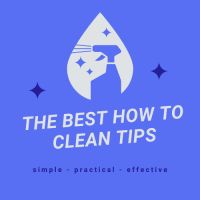I switched to cooking with cast iron exclusively a few years ago and have never looked back. An iron pan gives you even heating, is safer than synthetic non-stick coated pans, and will last a lifetime if maintained properly. Rusty cast iron pans are common finds at garage sales a flea market, so knowinghow to clean a cast iron skillet – even when it is rusty can result in a great bargain.
Avoid Moisture
The first rule of cast iron is to avoid moisture. That’s easier said
than done in a kitchen, so you may encounter rust spots on your cast
iron pan if you are not careful. In my experience, a little care and
attention to detail can salvage a rusty cast iron pan and get you back
to cooking.
How Much Rust
Your first step is to evaluate the severity of the rust. With mild
surface rust, a plastic scour sponge will loosen up most of the rust so
that you can clean it off in the next step.
If the rust is deeper into the iron pan, I use a vinegar soak. Mix
equal parts white vinegar and water and completely submerge the pan. Be
sure to keep an eye on the pan. I learned the hard way that an hour is
usually plenty of time to loosen the rust.
Removing The Rust
Next, I wash the rust away with soap and water. This is the only time
I ever purposely expose my cast iron skillet to water. Use a mild soap
and wash away the rust and any other debris.
I rinse the iron pan thoroughly and then let it sit on a hot burner
on the stove. That will ensure any excess water evaporates with the
heat.
Evaluate The Rust
Your first step is to evaluate the severity of the rust. With mild
surface rust, a plastic scour sponge will loosen up most of the rust so
that you can clean it off in the next step.
If the rust is deeper into the iron pan, I use a vinegar soak. Mix
equal parts white vinegar and water and completely submerge the pan. Be
sure to keep an eye on the pan. I learned the hard way that an hour is
usually plenty of time to loosen the rust.
Removing The Rust
Once I have removed the rust from the iron pan, it is time to re-season the skillet. Rub a thin coating of cooking oil over every surface of the iron pan, including the handle and the bottom. Then, put the oil on skillet and bake for an hour at 350 degrees. For this purpose, I use sunflower oil because of its high smoke point but any cooking oil will work.
Final Preparation Before Storage
After I have repaired a rusty pan, proper cleaning and storage are key. I use coarse salt and a dry rag to scrub out the pan after each use and a few drops to new oil to keep the seasoning fresh.
No water or soap is needed to clean properly seasoned cast iron. I also try to avoid cooking with acidic ingredients like tomatoes and wine as they may lead to rust.
I also keep a few sheets of paper towel in my pans while they are not in use. The paper towels help absorb moisture and create a little cushion between stacked pans.
Enjoy The Benefits
Now that you know how to avoid rust and re-season an iron pan. Most new cast iron skillets come pre-seasoned and ready to use. In my experience, used cast iron is a solid option too and can be found for affordable prices. Enjoy all the benefits of cooking with cast iron.
